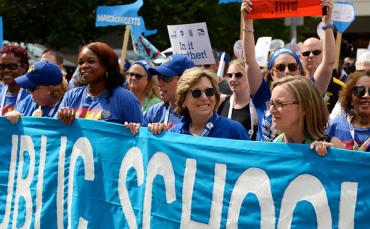Struggling in a ‘strong’ economy
The economy is coming up roses, if you believe Donald Trump’s Twitter feed. In between insults and exclamation points, President Trump likes to take credit for lowering taxes, creating jobs and revving up the stock market. But when you get in the weeds a little bit, a thornier picture comes into view. Most Americans aren’t benefiting from the tax cuts, profits and stock buybacks that corporations and wealthy investors are enjoying. Private sector employers have been adding jobs for 101 straight months, but workers’ real wages have barely budged in four decades as the cost of living has gone up. And, because half of all households don’t have a penny invested in stocks, most Americans haven’t hit the stock market’s jackpot.
There is a massive gap between Trump’s populist economic rhetoric and his actual policies. The “forgotten men and women” who Trump said have “borne the cost” as others amassed great wealth were overlooked somehow in his exorbitant tax cut for corporations and the wealthy. Companies aren’t using their tax windfall to raise workers’ wages or create more well-paying jobs; they’re rewarding investors and executives. Days after the 800 workers at Harley-Davidson’s Kansas City, Mo., plant learned they’d be out of a job, the company announced a dividend hike and stock buyback plan worth about $696 million for investors. And, in Indiana, workers at the Carrier plant that Trump boasted he “saved” live in constant dread, as the company slashes jobs in waves of hundreds.
Gas prices have hit the pain point for many Americans, and rising healthcare costs are eating into their paychecks. Student debt has surged to $1.5 trillion—up from $600 billion 10 years ago. The rate of people 65 and older who are filing for bankruptcy has tripled since 1991 as a result of higher healthcare costs, the decline in employer-provided pensions and, increasingly, their children’s college debt.
Rather than addressing this economic pain, Trump and his allies are making things even worse. They’re trying to bust unions. They’ve made it harder for defrauded borrowers to seek student debt relief. They’ve tried to gut the Affordable Care Act, and to slash federal support for summer school and after-school programs. And the Trump administration is rushing to pack federal courts, including the Supreme Court, with conservative, pro-business and anti-worker judges.
Working people understand that this power imbalance hurts them. Even as the Supreme Court—cheered on by the president—tried to decimate public sector unions by imposing anti-union, so-called right-to-work laws with its recent decision in Janus v. AFSCME, voters in Missouri last week did the opposite, repealing a state law that would have weakened unions by an emphatic 2-1 ratio. Polls show that public support for unions is at the highest level in many years—around 60 percent. Among adults under 30, a decisive 76 percent approve of unions. They understand that when we work together in unions, we can achieve what is impossible alone.
Teachers get it, too, as we saw in the recent teacher walkouts in states that have long underfunded public education in order to lavish large tax cuts on corporations and wealthy residents. In 25 states, public K-12 education has been stripped of $19 billion over the last decade, and low-tax Republican states are guilty of the worst underfunding. In 38 states, the average teacher salary is lower in 2018 than it was in 2009. Educators have blown the whistle on excessive tax cuts that benefit only those at the very top and eviscerate vital public services.
The big things that Americans need aren’t being addressed. Americans are clear about what they want elected leaders to do: Adequately fund public education, including pre-K, special education and higher education. Ensure that healthcare is accessible and affordable and covers people with pre-existing conditions. Rein in student debt; expand public service loan forgiveness; and prevent bad-actor federal loan services like Navient from abusing borrowers. Help working people secure a real raise, a real voice and the right to union representation. Fund infrastructure projects that make us safer while creating good jobs. Enact fiscal policies that help make the economy work for all. Protect the right to vote. Extend economic dignity and security into retirement. And display decency, as voters responding to last week’s Quinnipiac poll made clear: They dislike Trump almost 2-to-1, with majorities disapproving of not only his policies but his disparagement of those he disagrees with, particularly people of color, and his emboldening of racism, sexism and xenophobia.
Essayist Frank Rich recently wrote that the assumption that, over the long term, a rising economic tide would lift all Americans in equal measure is “dead and buried.” I hope not, but making that aspiration a reality will require Trump and other leaders to really, not rhetorically, put America’s “forgotten men and women” at the center of economic and social policies.

